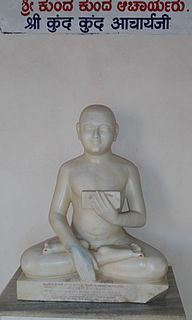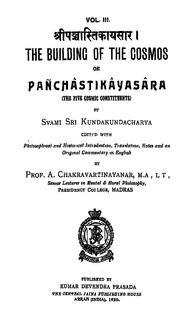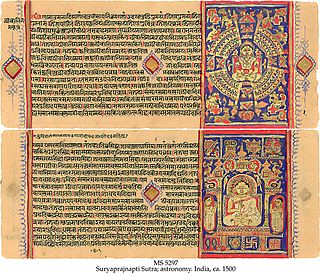Jainism, traditionally known as Jain Dharma is an ancient Indian religion. Followers of Jainism are called "Jains", a word derived from the Sanskrit word jina (victor) who connotes the path of victory in crossing over life's stream of rebirths by destroying the karma through an ethical and spiritual life. Jainism is a transtheistic religion, and Jains trace their spiritual ideas and history through a succession of twenty-four victorious saviours and teachers known as tirthankaras, with the first being Rishabhanatha, who according to Jain tradition lived millions of years ago, as Matsya the twenty-third being Parshvanatha in 900 BCE, and twenty-fourth being the Mahāvīra around 500 BCE. Jains believe that Jainism is an eternal dharma with the tirthankaras guiding every cycle of the Jain cosmology.

Ādi purāṇa is a 9th century Sanskrit poem composed by Jinasena, a Digambara monk. It deals with the life of Rishabhanatha, the first Tirthankara.

Acharya Kundakunda was a Digambara Jain monk and philosopher, who is still revered. He authored many Jain texts such as: Samayasara, Niyamasara, Pancastikayasara, Pravachanasara, Atthapahuda and Barasanuvekkha. He occupies the highest place in the tradition of the Digambara Jain acharyas. All Digambara Jains say his name before starting to read the scripture. Modern scholarship has found it difficult to locate him chronologically, with a possible low date in the 2nd-3rd centuries CE and a late date in 8th century.

Ṣaṭkhaṅḍāgama, literally the "Scripture in Six Parts", is the foremost and oldest Digambara Jain sacred text. According to Digambara tradition, the original canonical scriptures of the Jains were totally lost within a few centuries of Nirvana of Lord Mahavira. Hence, Satkhandāgama is the most revered Digambara text that has been given the status of āgama. The importance of the Satkhandāgama to the Digambaras can be judged by the fact that, the day its Dhavalā commentary was completed, it is commemorated as Shruta Pañcami, a day when all the Jaina scriptures are venerated. Satkhandāgama, the first āgama is also called the Pratham Shrut-Skandh, while the Panch Paramāgama by Acharya Kundakunda are referred to as the second āgama or Dvitiya Shrut-Skandh.

Pañcastikayasara, is an ancient Jain text authored by Acharya Kundakunda. Kundakunda explains the Jain concepts of dravya (substance) and Ethics. The work serves as a brief version of the Jaina philosophy. There are total 180 verses written in Prakrit language. The text is about five (panch) āstikāya, substances that have both characteristics, viz. existence as well as body.
Yapaniya was a Jain order in western Karnataka which is now extinct. The first inscription that mentions them by Mrigesavarman a Kadamba king of Palasika who donated for a Jain temple, and made a grant to the sects of Yapaniyas, Nirgranthas, and the Kurchakas.

Kevala jñāna means omniscience in Jainism and is roughly translated as complete understanding or supreme wisdom.

Jain literature comprises Jain Agamas and subsequent commentaries on them by various Jain asectics. Jain literature is primarily divided between Digambara literature and Svetambara literature. Jain literature exists mainly in Magadhi Prakrit, Sanskrit, Marathi, Tamil, Rajasthani, Dhundari, Marwari, Hindi, Gujarati, Kannada, Malayalam, Tulu and more recently in English.

Guṇasthāna are the fourteen stages of spiritual development and growth through which a soul gradually passes before it attains moksha (liberation). According to Jainism, it is a state of soul from a complete dependence on karma to the state of complete dissociation from it. Here the word virtue does not mean an ordinary moral quality, but it stands for the nature of soul — knowledge, belief and conduct.

Ratnakaranda śrāvakācāra is a Jain text composed by Aacharya Samantbhadra Swamy, an acharya of the Digambara sect of Jainism. Aacharya Samantbhadra Swamy was originally from Kanchipuram, Tamil Nadu. Ratnakaranda śrāvakācāra is the earliest and one of the best-known śrāvakācāra.
Tiloya Panatti or Trilokaprajnapati is one of the earlier Prakrit texts on Jain cosmology composed by Acharya Yativrshabha.
The Jīva or Atman is a philosophical term used within Jainism to identify the soul. As per the Jain cosmology, jīva or soul is the principle of sentience and is one of the tattvas or one of the fundamental substances forming part of the universe. The Jain metaphysics, states Jagmanderlal Jaini, divides the universe into two independent, everlasting, co-existing and uncreated categories called the jiva (soul) and the ajiva (non-soul). This basic premise of Jainism makes it a dualistic philosophy. The jiva, according to Jainism, is an essential part of how the process of karma, rebirth and the process of liberation from rebirth works.

Aacharya Umaswami, also known as Umaswati, was an early 1st-millennium Indian scholar, possibly between 2nd-century and 5th-century CE, known for his foundational writings on Jainism. He authored the Jain text Tattvartha Sutra. Umaswati's work was the first Sanskrit language text on Jain philosophy, and is the earliest extant comprehensive Jain philosophy text accepted as authoritative by all four Jain traditions. His text has the same importance in Jainism as Vedanta Sutras and Yogasutras have in Hinduism.

Jain scriptures are called Agamas. Categories of Agamas are:

Pravachanasara, is a text composed by Jain monk, Kundakunda, in the second century CE or later. The title means "Essence of the Scripture", and it largely deals with the correct ascetic and spiritual behavior based on his dualism premise. Kundakunda provides a rationale for nudity among Digambara monks in this text, stating that the duality of self and of others means "neither I belong to others, nor others belong to me, therefore nothing is mine and the ideal way for a monk to live is the way he was born". The text is written in Prakrit language, and it consists of three chapters and 275 verses.
Harisena was a tenth century Digambara monk. His origin is traced to those monks who had stayed in the north during the supposed famine and had been prevailed upon by their lay followers to cover their private parts with a strip of cloth (ardhaphalaka) while begging for alms.
Jayasena was a twelfth century Digambara Jain Acharya who wrote Tattparyavritti, a commentary on Acharya Kundakunda's Pravachanasara.

Uttarapurana is a Jain text composed by Acharya Gunabhadra in the 9th century CE.
Padmanabh Shrivarma Jaini is an Indian born scholar of Jainism and Buddhism, currently living in Berkeley, California, United States. He is from a Digambar Jain family; however he is equally familiar with both the Digambara and Svetambara forms of Jainism. He has taught at the Banaras Hindu University, the School of Oriental and African Studies (SOAS), the University of Michigan at Ann Arbor and at the University of California at Berkeley, from which he retired in 1994. Professor Jaini is the author of several books and papers. His best known work is The Jaina Path of Purification (1979). Some of his major articles have been published under these titles: The Collected Papers on Jaina Studies (2000) and Collected Papers on Buddhist Studies (2001).

University of California Press, otherwise known as UC Press, is a publishing house associated with the University of California that engages in academic publishing. It was founded in 1893 to publish books and papers for the faculty of the University of California, established 25 years earlier in 1868. Its headquarters are located in Oakland, California.

The International Standard Book Number (ISBN) is a numeric commercial book identifier which is intended to be unique. Publishers purchase ISBNs from an affiliate of the International ISBN Agency.














